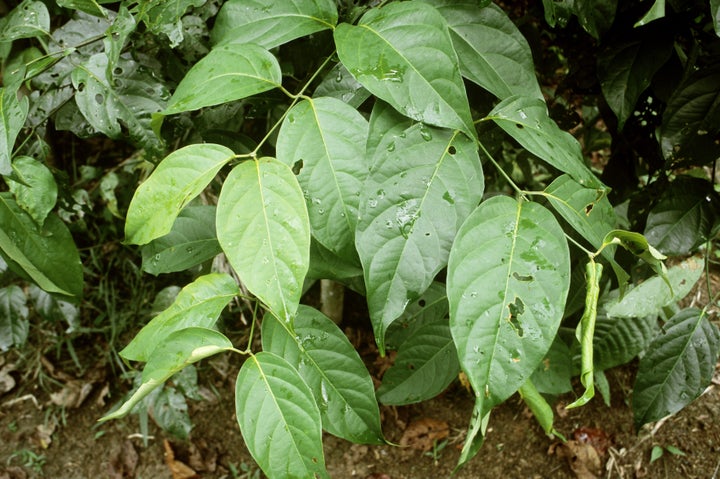Ayahuasca has been used in religious ceremonies for centuries. Called the "vine of the soul," ayahuasca is a brew typically made from the Banisteriopsis caapi vine and Psychotria viridis leaves that grow predominantly in Brazil, Peru and other regions of South America. The resulting tea contains DMT, which the Drug Enforcement Administration classifies as an illegal hallucinogen, despite its long history of use in religious rituals.
Ayahuasca is frequently referred to as a "medicine" and has been used by shamans in South America for centuries, though it has only garnered popular awareness in North America in recent decades. On Sept. 25, dozens of doctors, researchers, spiritual teachers and artists will converge in Los Angeles for a three-day conference to discuss the use of ayahuasca and other psychoactive plants for spiritual healing and personal growth.

The Visionary Convergence, as the event is titled, aims to bring awareness to the growing interest in “entheogenic plants,” defined by Oxford dictionary as “a chemical substance, typically of plant origin, that is ingested to produce a non-ordinary state of consciousness for religious or spiritual purposes.”
This interest is starting to have legal, cultural and academic effects in the U.S. In 2006 the U.S. Supreme Court ruled that the Uniao do Vegetal or UDV church had the right to exist -- and to drink ayahuasca during its services. Ayahuasca is also appearing as a topic of one of the workshops at the Parliament of the World's Religions, a major international interfaith conference taking place in Salt Lake City this October.
The Los Angeles conference will address these and other repercussions of ayahuasca's rapidly growing popularity in North America. Sitaramaya, who goes by Sita, is the organizer of the Visionary Convergence and spoke with The Huffington Post about her experience with the powerful entheogenic brew. A Los Angeles-based shaman trained in the Peruvian Shipibo tradition, Sita is also the director of the Capital Case Project, an organization that advocates for people on death row.
Note: Ayahuasca can have dangerous and even fatal results when not brewed properly or administered with proper care. Sita stressed that it is a powerful, psychoactive substance that practitioners should use only in a ceremonial setting under the careful guidance of a shaman.
HP: How did you first encounter ayahuasca and what effect did it have on you?
Sita: I got sober from drugs and alcohol when I was 25 years old and started a yoga practice at the time. I was introduced to the concept of ayahuasca through my yoga teacher in 1996, and I was pretty staunchly opposed to drug use. But there was a kindred feeling between myself and my yoga teacher, and when I witnessed my teacher I thought, ‘Wow, this teacher is walking the walk.’ There was a disconnect between what I thought drugs were and what I was witnessing and what I was learning.
I had to sit with it for a year. I practiced and I sat with it and then I thought, ‘I’m feeling really drawn to this.’ Then it was another year before I got the opportunity, and I took it. My first ceremony was in 1998. My life changed after that. Ayahuasca didn’t change my life but my life changed as a result of that initial experience.
Descriptions of the effects of ayahuasca range from "an oceanic feeling of connectedness" to "feeling as though one is dying." How would you describe the plant and the experience of drinking it?
Words really fail us here. It’s like trying to understand some esoteric teaching, but it’s just an approximation because it’s not something that’s really knowable. Ayahuasca is a deeply personal, individual and, very frequently, spiritual experience. Much of how we experience drinking ayahuasca is influenced by the setting in which we drink, who and how we are physically, emotionally, spiritually, psychically, and intellectually when we drink. I can speak to my observations and experience of drinking ayahuasca in the Peruvian Shipibo lineage that ayahuasca calls forth within us that which needs or desires to be cleared, cleaned, healed, aligned, transformed or expanded.
The experience is one of a shift in perspective and perception. It can be retrospective, introspective. It can be the most challenging experience you have ever had or divine bliss. It has been said that it is like dreaming while awake and I would agree with that.
Do you personally find ayahuasca ceremony to be a spiritual experience?
For me it’s a very deeply spiritual process. To try and capture the ineffable is ridiculous but for many of us it’s irresistible. My motivation in these endeavors is a quest for meaning and also a surrender to that which we are not going to be able to know. The spiritual part of that experience is unfolding some of the source of creation and then we know that there exists what can’t be known.
Can you share some examples from ceremonies you’ve been in?
I once had an experience in an ayahuasca ceremony of these sheets of light unfolding repeatedly. It was as if in the seam of each one was a light that I experienced as all that is, but then it would fold back again. I came to this place of understanding -- we can keep going but there’s nothing behind that screen. You could pull back that curtain but it would just be another curtain. It never ends. We are that, born into human form. I believe that it’s our soul taking form to know the divine within.
Another experience I had many years ago in Brazil happened after I did a 28-day dieta (a process of developing and cultivating a relationship with a particular plant while restricting intake of other foods and substances.) Midway through I had a vision of a crystalline palace up on a mountain top with tiers leading up to it. Those tiers represented the suffering of the universe: fire, floods, dismembered bodies. I cried and cried and cried with this deep spiritual connection I felt to all the hurt. The palace represented everything is divine. We all get to go to that palace but some of us are doing it with a limb hanging off our body. It was so moving. I felt just very deep compassion and connection, and for me that’s very spiritual.
What is your aim for the Visionary Convergence?
From a broad spectrum approach it is to cultivate entheogenic awareness. ‘Entheo’ means ‘of god,’ so ‘entheogenic’ is something that allows us to know god within ourselves. Many people believe, as do I, that certain plants are opportunities to do that. Our hope is to cultivate awareness and to really think about how we want to define medicine in the 21st century and how entheogenic plants will play a part in that. We’re bringing together people from multiple disciplines to really open up this conversation. What I hope is we come out of it with more questions than we do answers.
This interview has been edited for length and clarity.
Watch Sita deliver an "ayahuasca monologue" below:
Also on HuffPost:
